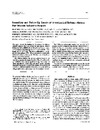Please use this identifier to cite or link to this item:
https://accedacris.ulpgc.es/jspui/handle/10553/74261
| Title: | Immediate and follow-up results of transluminal balloon dilation for discrete subaortic stenosis | Authors: | Suárez de Lezo, José María Pan, Manuel Medina, Alfonso Romero, Miguel Melián, Francisco Segura, José Hernández, Enrique Pavlovic, Djordje Morales, Juan Vivancos, Ricardo Ramón Ortega, José |
UNESCO Clasification: | 320501 Cardiología | Keywords: | Subvalvular Aortic-Stenosis Dilatation Regurgitation Valvuloplasty |
Issue Date: | 1991 | Journal: | Journal of the American College of Cardiology | Abstract: | This study presents the findings in 33 patients with discrete subaortic stenosis who were treated by percutaneous balloon dilation and were followed up for 2 months to 6.2 years (mean 34 +/- 21 months). The mean age was 13 +/- 11 years; 10 (30%) were female and 23 (70%) male. Associated malformations were observed in nine patients (27%). All patients underwent noninvasive studies and cardiac catheterization. The mean valve to membrane distance was 4.5 +/- 2 mm/m2.After balloon dilation, the pressure gradient from the left ventricle to the aorta decreased from 68 +/- 30 to 20 +/- 13 mm Hg (p < 0.00001); there were no significant changes in the degree of aortic regurgitation. A fluttering and widely mobile remaining membrane was clearly visualized after dilation. Better immediate results were obtained in patients with a smaller baseline gradient, a larger aortic anulus and a longer valve to membrane distance.Serial follow-up echographic studies were available in 30 patients, and 18 hemodynamic reevaluations were performed in 13 patients. However, seven patients who demonstrated restenosis underwent redilation at a mean of 29 +/- 17 months after the first dilation. Redilation in six of the seven patients obtained benefits similar to those observed at the first dilation. Only one patient with unsuccessful redilation required surgery. The mean value of the last explored residual gradient (on hemodynamic or Doppler study) in the remaining 32 patients was 21 +/- 10 mm Hg. No significant changes were observed in the angiographic evolution of aortic regurgitation.In conclusion, percutaneous balloon dilation may be a useful complement to surgical therapy in patients with a thin discrete subaortic stenosis. However, close follow-up is needed. | URI: | https://accedacris.ulpgc.es/handle/10553/74261 | ISSN: | 0735-1097 | DOI: | 10.1016/0735-1097(91)90553-L | Source: | Journal of the American College of Cardiology [ISSN 0735-1097], v. 18 (5), p. 1309-1315, (Noviembre 1991) |
| Appears in Collections: | Artículos |
WEB OF SCIENCETM
Citations
21
checked on Jun 8, 2025
Page view(s)
106
checked on Jan 4, 2025
Download(s)
160
checked on Jan 4, 2025
Google ScholarTM
Check
Altmetric
Share
Export metadata
Items in accedaCRIS are protected by copyright, with all rights reserved, unless otherwise indicated.
